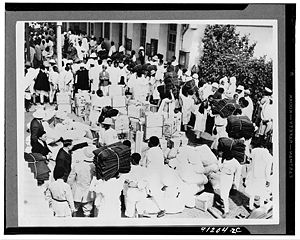
Cotton production in Ethiopia
Encyclopedia


Cotton
Cotton is a soft, fluffy staple fiber that grows in a boll, or protective capsule, around the seeds of cotton plants of the genus Gossypium. The fiber is almost pure cellulose. The botanical purpose of cotton fiber is to aid in seed dispersal....
is grown throughout Ethiopia at elevations above 1000 meters and below 1400 meters. Because most of the lowlands lack adequate rainfall, cotton cultivation depends largely on irrigation.
History
Cotton production has long been underway in Ethiopia. Before the revolution, large-scale commercial cotton plantations were developed in the Awash Valley and the Humera areas. The Tendaho Cotton Plantation in the lower Awash Valley was one of Ethiopia's largest cotton plantations. Rain-fed cotton also grew in HumeraHumera
Humera is a town in northern Ethiopia, near the borders of Sudan and Eritrea. Located in Mi'irabawi Zone of the Tigray Region, this town has a latitude and a longitude of . Humera is the administrative center of Kafta Humera woreda.- Overview :Humera is served by Humera Airport...
, Bilate
Bilate River
The Bilate is a river of south-central Ethiopia. It rises on the southwestern slopes of Mount Gurage near , flowing south along the western side of the Great Rift Valley, to empty into Lake Abaya at...
, and Arba Minch
Arba Minch
Arba Minch is a city in southern Ethiopia; less common names for this city include Ganta Garo and Minghi. Located in the Gamo Gofa Zone of the Southern Nations, Nationalities, and Peoples Region about 500 kilometers south of Addis Ababa, at an elevation of 1285 meters above sea level...
.
In 1867 it was reported that there were plans to construct a 225 mile road from the Ethiopian cotton fields to the Red Sea
Red Sea
The Red Sea is a seawater inlet of the Indian Ocean, lying between Africa and Asia. The connection to the ocean is in the south through the Bab el Mandeb strait and the Gulf of Aden. In the north, there is the Sinai Peninsula, the Gulf of Aqaba, and the Gulf of Suez...
to trade with Egypt and Turkey. Since the revolution, most commercial cotton has been grown on irrigated state farms, mostly in the Awash Valley area. Production jumped from 43,500 tons in 1974/75 to 74,900 tons in 1984/85. Similarly, the area of cultivation increased from 22,600 hectares in 1974/75 to 33,900 hectares in 1984/85.
Given its excellent growing conditions, abundance of raw materials and availability of land, Ethiopia has the potential to become a major global cotton producer but the cotton industry in Ethiopia as of 2011 is far behind that of the coffee industry
Coffee production in Ethiopia
The coffee production in Ethiopia is critical to the Ethiopian economy with about 25% of the population depending directly or indirectly on coffee for its livelihood...
and cereal production. There are however, significant obstacles to the development of the industry in Ethiopia due to a distinct lack of administrative bodies to monitor and certify agricultural practices in the country and to process cotton in factories on a wide-scale commercial level. However, the development of the textile industry is a priority of the Ethiopian government in their economic growth strategy and in 2006 implemented an important privatization initiative to attract foreign and private enterprises to develop the sector. Despite its lack of governance, the Ethiopian cotton industry is self-sufficient and as of 2002 provides some 50,000 tons annually to the textile industry of Ethiopia.

